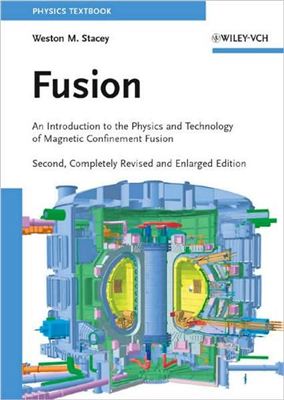WILEY-VCH Verlag GmbH & Co. KGaA, Weinheim, 2010, 246p.
The purpose of this book is to provide the reader with a broad and comprehensive
introduction to the multidisciplinary subject of magnetic fusion. The material is selfcontained
in that each topic is developed from first principles to engineering
application. Relevant physical property data are included where appropriate. The
text evolved from lecture notes for a two-course sequence that is offered to advanced
undergraduates and first-year graduate students at Georgia Tech.
An overview of the principles, status, and prospects for magnetic fusion is given in
the first chapter. Basic properties of magnetically confined plasmas are developed
and applied to establish the principles of the major confinement concepts in
Chapters 2–
4. The following two chapters deal with subjects involving in equal
measure plasma physics and technology – plasma heating and the plasma–wall
interaction. Major technological systems – magnets, energy storage and transfer,
blanket and shield, tritium and vacuum – and their underlying technologies are
treated in Chapters 7–
11. The final chapter deals with the synthesis of the preceding
material in fusion reactor design, emphasizing the interaction among the various
physics and technology constraints. A summary of recent conceptual designs is
provided. The book is intended as a text for introductory courses on magnetic fusion physics
and technology at the advanced undergraduate or first-year graduate level. It should
also serve the needs of practicing engineers and scientists who wish to obtain a broad
introduction to the subject. The material is accessible to anyone with a background
equivalent to that of an advanced undergraduate in engineering or physics.
The quest after fusion power is exciting and demanding. The scientific, technical,
and institutional challenges that must be met will require the dedication of the best
minds that our society can produce for many years to come. But the ultimate reward
for success will be enormous.
Contents
Introduction
Basic Properties
Equilibrium and Transport
Confinement Concepts
Plasma Heating
Plasma–Wall Interaction
Magnetics
Transient Electromagnetics
Interaction of Radiation with Matter
Primary Energy Conversion and Tritium Breeding Blanket
Tritium and Vacuum
Fusion Reactors
The purpose of this book is to provide the reader with a broad and comprehensive
introduction to the multidisciplinary subject of magnetic fusion. The material is selfcontained
in that each topic is developed from first principles to engineering
application. Relevant physical property data are included where appropriate. The
text evolved from lecture notes for a two-course sequence that is offered to advanced
undergraduates and first-year graduate students at Georgia Tech.
An overview of the principles, status, and prospects for magnetic fusion is given in
the first chapter. Basic properties of magnetically confined plasmas are developed
and applied to establish the principles of the major confinement concepts in
Chapters 2–
4. The following two chapters deal with subjects involving in equal
measure plasma physics and technology – plasma heating and the plasma–wall
interaction. Major technological systems – magnets, energy storage and transfer,
blanket and shield, tritium and vacuum – and their underlying technologies are
treated in Chapters 7–
11. The final chapter deals with the synthesis of the preceding
material in fusion reactor design, emphasizing the interaction among the various
physics and technology constraints. A summary of recent conceptual designs is
provided. The book is intended as a text for introductory courses on magnetic fusion physics
and technology at the advanced undergraduate or first-year graduate level. It should
also serve the needs of practicing engineers and scientists who wish to obtain a broad
introduction to the subject. The material is accessible to anyone with a background
equivalent to that of an advanced undergraduate in engineering or physics.
The quest after fusion power is exciting and demanding. The scientific, technical,
and institutional challenges that must be met will require the dedication of the best
minds that our society can produce for many years to come. But the ultimate reward
for success will be enormous.
Contents
Introduction
Basic Properties
Equilibrium and Transport
Confinement Concepts
Plasma Heating
Plasma–Wall Interaction
Magnetics
Transient Electromagnetics
Interaction of Radiation with Matter
Primary Energy Conversion and Tritium Breeding Blanket
Tritium and Vacuum
Fusion Reactors

